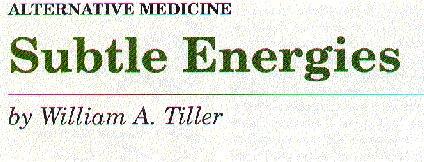
Science & Medicine May / June 1999 Volume 6, Number 3

Dr. William A. Tiller joined the Stanford University faculty as Professor of Physics in 1964 after nine years with Westinghouse Research Laboratory. He became Professor Emeritus in 1992 in order to devote himself to research in solid state physics and materials science as well as in his avocational field, psychoenergetics. He holds several patents, and he has written four books and more than 300 papers.
There is now a large body of experimental data in the general area of psychoenergetics associated with the directed focus of human intention. Remote influence experiments with healers, remote viewing experiments, investigations of psychokinetics, clairvoyance, homeopathy, and other phenomena confound the established picture of natural laws but attest to the existence of processes requiring the involvement of emotional, mental, spiritual, and other inadequately understood domains of nature.
Because these domains are incompletely understood, they might best be grouped into a category called "subtle energies." Future research may delineate and distinguish the various characteristics of these energies and their usefulness in medicine. For now, subtle energies can be defined as all those energies beyond those presently acknowledged in physics. Four kinds of force are-conventionally considered to be responsible for all the observable phenomena in the universe: the strong and weak nuclear forces, the electromagnetic force, and the gravitational force. Subtle energies and the subtle forces they generate are not necessarily strong or weak with respect to the established forces, but they are difficult to nail down with the standard protocols of today's science. It is useful to reflect for a moment on what the science of physics is able to do and not able to do. Physics attempts to develop a relative framework of quantitative understanding that is internally consistent across all the various observable phenomena of nature. Physics is not able to provide absolute truth.
Periodically, the prevailing model of physics is unable to provide internal consistency when incorporating new sets of experimental observations. The choice is then to either deny that the new observations are valid or expand the model of nature sufficiently to allow natural incorporation of the new data.
Such a revision in the standard model was required when quantum and relativity phenomena had to be accounted for. Today, the majority of the physics community is in a state of denial with respect to psycho- energetic phenomena. The present model is so neat, powerful, and comfortable that many people feel it would be a shame to have to disturb it. However, evolution moves on, in spite of prevailing paradigms.
A body of compelling experimental data is required to nudge the prevailing professional mind-set out of a long-standing rat and into a more fruitful perspective. To encourage the process, I describe here a half dozen experiments dealing with directed human intention. Each experiment indicated robust manifestations in physical reality of phenomena that are quite inexplicable within the prevailing physics model of nature. I was involved with five of these experiments and can vouch for the care and effort invested in them.
In the 1970's, I carried out a series of experiments I with a man who had the ability to so energize a camera and its film that whenever he took a picture while he was experiencing a certain feeling in his seventh cervical and fourth thoracic vertebrae, some striking anomaly would appear in the photograph. His held intention during the picture-taking process was, he said, "to reveal God's universe." My experiments used two cameras, one of them sensitized by keeping it close to the subject's body for several days. Both cameras were mounted on the same tripod and tripped with a single shutter release. Ordinary color film was used and was processed by its manufacturer, and the subject was never allowed to touch the film. Often, though not always, pictures taken with the sensitized camera showed one or more people as if they were partially transparent, or translucent, while pictures from the unsensitized camera appeared normal. It was also possible for the sensitized camera to take pictures through its lens cap.
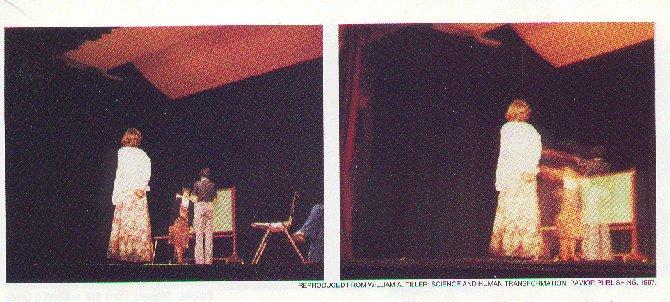
Examples of paired photographs from the dual camera study. The photograph at the right was taken with the sensitized camera.
My interpretation of this phenomenon is that (1) some radiations exist in nature that can travel through materials that are opaque to visible light; (2) because of some unknown quality inherent in the subject's energy field, these radiations can be detected by the film in the sensitized camera; (3) some time is required for the camera placed in this special energy field to acquire its anomalous capability; and (4) the anomalous capacity leaks away in about an hour unless continuously pumped by the energy field of the subject.
In a second set of studies, an AC voltage at 450 Hz I was applied to dielectric coated electrodes that bounded a 2 mm layer of gas in a sandwich-like gas discharge device. The voltage peak was kept 10 to 15% below the breakdown threshold for the gas, and electron "microavalanches" passing through the gas were monitored by a pulse counter that could be set to count any pulse over a predetermined size. Typically, the pulse counter was set so as to just miss the largest microavalanches traveling across the gas. Thus the system was poised but yielding a zero count for many hours until a human subject attempted to influence it. Most of a thousand or so experimental runs involved a person holding his hands about six inches from the device and intending to increase the count rate. Over a five-minute period, the number of recorded pulses was often in the range of 50,000.
If the subject's hands were not held near the device but the intention was still to increase the rate, total counts could be increased from zero to the range of 10,000 to 20,000 within five minutes. If the subject's intention was directed away from the device by being focused on a different mental task, no change in the count rate occurred.
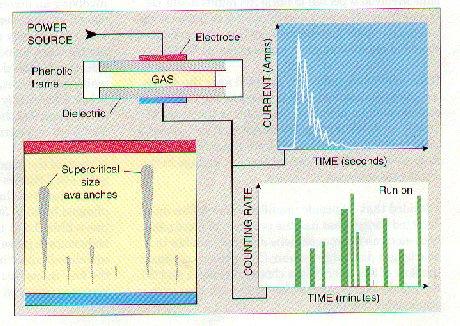
The gas discharge experimental setup comprised a high-fidelity, high-voltage power source, the gas discharge device, and a monitoring system. This schematic illustration shows electron avalanches passing through the gas, a typical oscilloscope tracing of total electron avalanche current vs. time, and a plot of the count rate as a function of time during an experimental run.
I decided that (1) people manifest a heretofore undetected energy that has the property of increasing both electron microavalanche size and number in a nearby gas discharge system; (2) a person can direct the flow of this energy in a chosen direction; and (3) the mind-electron interaction can be effective over appreciable distances.
Elmer Green and his associates at the Menninger Clinic devised a simulated healing experiment involving an accomplished healer in a specially designed environment within a larger room. The healer, wired to a variety of electrophysiological measurement instruments, stood or sat on an electrically insulated framework placed within four large, square copper walls, one in front, one behind, one above, and one below. Electrically insulated electrometers simultaneously recorded the voltages of these four walls plus that from an electrode placed on the healer's earlobe.
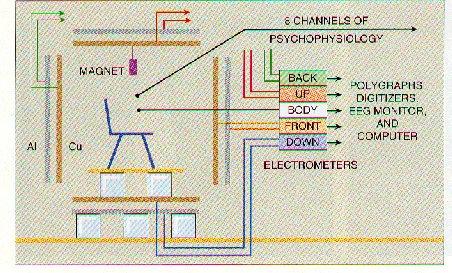
In the copper-walled meditation room, four pairs of insulated copper and aluminum panels float in electrical space around a research chair, which also floats electrically, insulated from the "down" panel by glass construction blocks. Signals from the subject's body and from the four copper walls are fed into electrometers, and data from all channels are forwarded to polygraphs, digitizers, and a computer. The graph below shows an example of simultaneous body and wall potentials.
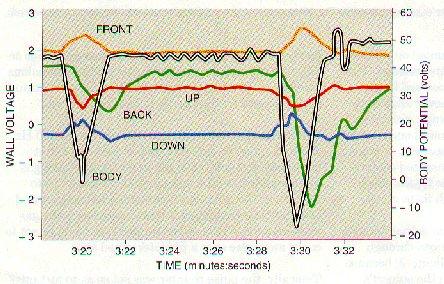
Instead of the expected 10 or 15 mV baseline reading with 1-mV ripples that are typical of the human body, it was observed that the healer's body voltage often plunged by 30 to 300 volts and then returned to baseline within 0.5 to 10 seconds. This astoundingly large body voltage pulse is about 100,000 times normal, and correlated pulses of 1 to 5 volts appeared on each of the four copper walls. In a 30-minute session, the healer manifested 15 of these anomalously large pulses.
From this experiment, I generated a theoretical model of a nonobservable subtle energy pulse emitted at some location in the healers body, transduced through a series of stages, and manifest as an electric dipole pulse at a specific location in the body. With this, I was able to make a quantitative analysis of the data from the 15 pulses.
In 13 of the 15 pulses the place of origin was the lower abdomen. The dipole was predicted to extend from the ear (negative charge end) to the feet (positive charge end), but only a small current had to flow for a short time to achieve the result. Such a current flow is much less than typically observed when any two different acupuncture points on the body are connected.
For the other two of the anomalous pulses, it was necessary to propose the formation of two simultaneous electric dipole pulses to account for the different type of data observed, and the location of the second dipole was predicted to be in the head.
What I deduced from this study was that (1) the healer's intention to heal can manifest ultimately as large, observable electric voltage pulses in physical reality; (2) some medium exists that couples the non-observable subtle energy to an observable physical energy; and (3) a precise mathematical analysis can be generated to concretize this elusive concept.
The fourth experiment was carried out at the Institute of HeartMath about five years ago and involved the psychokinetic act of remotely winding or unwinding DNA strands on soluble DNA particles in aqueous solution by accomplished practitioners of the heart focus technique called "freezeframe." The average winding state of the DNA molecules was determined using ultraviolet absorption spectroscopy. The mode of heart function was determined from the practitioner's electrocardiogram.
The freezeframe technique consists of consciously disengaging mental and emotional reactions to external and internal events and shifting the center of attention from the brain and the emotions to the physical area of the heart while focusing on someone or something to love or sincerely appreciate. These heart-focused feelings produce profound changes in the practitioner's heart rate variability, connoting an ordered mode of heart function that entrains other key body processes so that, overall, a type of body coherence is attained.
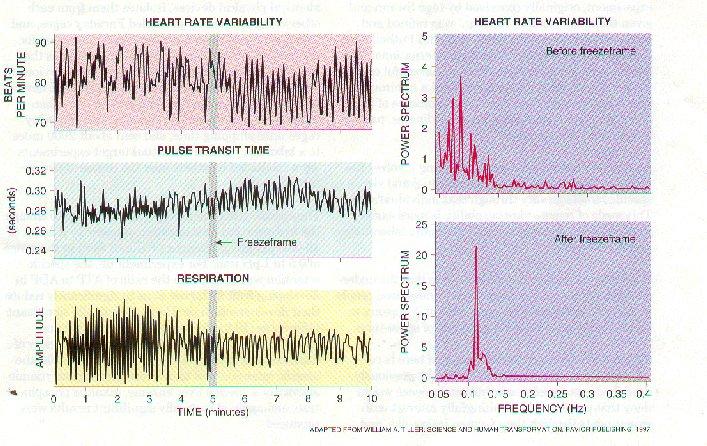
Abrupt changes were seen in heart rate variability, pulse transit time, and respiratory rate after a practitioner entered the freezeframe state. Heart rate variability is shown as an example of how Fourier transforms of these real-time plots showed entrainment of all three data signatures to a narrow region around the baroreflex frequency, 0.1 to 0.15 Hz.
Using five trained practitioners for a total of 10 trials on different days, heart rate variability, plots were used to indicate when a practitioner was in an entrained state. While holding a vial of DNA solution in the left hand, the practitioner was asked to focus on the water and intentionally alter the DNA!s state of winding for a period of five minutes. There was a statistically significant difference in the intentionally treated water compared to controls.
It was interesting to note that for this study, the necessary and sufficient conditions for success were twofold: (1) the practitioner had to be in an ordered mode of heart function, and (2) the practitioner had to intend to influence the DNA's winding state. If either of these conditions was absent, then there was a negligible change in the UV absorbance of the DNA solution.
What can be deduced from this study is not only that intention is important in producing such a psychokinetic effect but that (1) the physiological state of the practitioner plays a key role in the process, and (2) the inner self-management discipline developed by these practitioners allowed easy entry into this state of body coherence, which in turn provided multiple electrical and chemical benefits for the body.
The fifth experiment involves the conscious cognition of objects, terrain, atmospheric conditions, and so forth, located hundreds to thousands of miles away, given only the coordinates of the location. This experiment, originally conceived by Ingo Swann and given the name "remote viewing," was refined and perfected by him in association with Hal Puthoff and Russell Targ at Stanford Research International. For government service remote viewers, successful completion of a training program required a minimum of 85% accuracy with respect to the coordinates of 20 blind targets. In some cases time coordinates, past or future, were also involved.
A more familiar mode of remote viewing involves the ability to "tune in" to a specific individual and view a specific remote locality through that individual's eyes. This mode of remote viewing ability is more easily acquired and has been replicated in many laboratories around the world.
What one can deduce from this study is that the understanding of information acquisition by developed people is woefully inadequate because some of it appears to involve processes functioning outside of space-time.
The last experiment to be described here is currently ongoing. Unfamiliar with the previously described experiments, conventional science would deny that people could meaningfully interact with experiments through their focused intentions, and even less so via an intermediary electronic device. Within the framework of this general experiment, I have selected three specific target experiments and found the present paradigm to be fallacious.
For each target experiment, one starts with two identical physical devices, isolates them from each other using electrically grounded Faraday cages, and "charges" one of them with the specific intention for the particular experiment, the other serving as the control. This charging process involved the services of four highly qualified meditators to imprint the device with the specific intention. The devices were then wrapped in aluminum foil, stored in their Faraday cages until shipping time, and sent about 2000 miles to a laboratory where the actual target experiments were conducted by others over the course of two or three months.
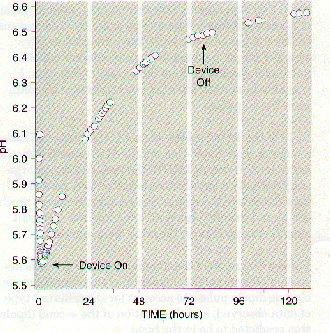
pH vs. time during the operation of an intention-imprinted electronic device.
The specific intention for experiment 6a was to change the hydrogen ion concentration of water by a factor of 10 (one pH unit). Changes produced were in the range of 0.5 to 1 pH unit. For experiment 6b, the specific intention was to increase the ratio of ATP to ADP in developing fruit fly larvae so as to significantly reduce their development time. Here, statistically significant differences (10 to 15%) in development time and , energy metabolism were observed under a variety of experimental circumstances. For experiment 6e, the specific intention was to increase the thermodynamic activity of a specific liver enzyme, alkaline phosphatase, and again statistically significant results were produced.
Continued research with these water target experiments is revealing that (a) the local environment of the experiment is becoming conditioned so as to allow more ready response to the "prime directive" of the specific intention and (b) a form of local coherence develops that manifests as strong correlations between simultaneous multiple test site data, even when the test sites are as much as 900 feet apart.
What can be deduced from this study is that (1) people with sufficient training, inner self-management, and coherence appear to be able to imprint a specific intention into an electronic device; (2) such a device can retain its intention charge for several months; (3) the prime directive of the device's intention charge appears to activate a previously undetected thermodynamic potential in nature that modifies existing physical processes in inorganic and organic materials as well as simple life forms so as to enhance the vector of change stipulated by the intention; (4) this overall process seems to involve some form of coherence in space-time; and (5) this local coherence grows in time with continued use of the target devices.
It is still early days with respect to this type of experimentation. With only about two years' experience with these three target experiments to date, much has yet to be learned.
At least seven unique and important conclusions can be drawn from these six experiments:
Directed human intention can have robust effects in physical reality.
The magnitude of the intention-generated physical effects increases with continued inner self-management practice and thus growing coherence of the human source.
Directed intention must be considered as a thermodynamic potential and a significant experimental variable in any future paradigm concerning natural law.
Energies function in the universe that defy the present physical domain perspective and can be directed by sufficiently developed people.
Simple electronic systems can serve as a long-lasting host for these special energies and intentions. Such devices can broadcast their prime directive, which in turn appears to act as a controlling element in the physical processes needed to fulfill the prime directive.
Structure appears to exist in nature beyond the current view of space-time, and developed people have the capacity to access valuable information from such nonspatially and nontemporally limited channels.
The structure of space-time appears to adapt to continued use of intention-imprinted electronic devices and to develop coherence-like properties.
These conclusions, I expect, will significantly impact any efforts to model the structure of the universe in a way that will allow these psychoenergetic phenomena to comfortably coexist with currently accepted phenomena in a more useful "world view."
For today's medicine, this new data sheds strong Flight on the so-called placebo effect. The prevailing medical view is that nothing real has occurred and that any improvement is delusional. In Herbert Benson's work among patients receiving a variety of treatments they believed in, but for which medicine finds no physiological basis, treatments were effective 70% to 90% of the time. However, when physicians doubted whether these treatments worked, their effectiveness dropped to 30% to 40%.
Similar belief-related success was observed in Stewart Wolf's work with women who experienced persistent nausea and vomiting during pregnancy. Sensors were positioned in their stomachs so that contractions could be recorded. Next, they were given a drug that they were told would cure their nausea. In fact, they were given ipecac. However, because of their belief, the women reversed the laboratory-proven action of the drug, and their measured stomach contractions damped down to negligible values.
From these studies and many more like them, it can be seen that belief fuels expectations, and expectations in turn marshal intention at both unconscious and often conscious levels to fulfill the expectations. The six experiments described here tend to both scientifically validate that perspective and also illuminate some of the factors involved. For future medicine, once the presently prevailing mind-set is bypassed, a remarkably powerful technology waits to be unfolded in the service of the healing arts. There are also some serious limitations in the present physics paradigm that need to be corrected with a new model having sufficient predictive power to accommodate comfortably both the old data and the new unfolding data.
FOR MORE INFORMATION
William A. Tiller: Science and Human Transformation: Subtle energies, intentionality, and consciousness. Pavior Publishing, 1997. http://www.tiller.org
Ingo Swann: To Kiss the Earth Goodbye. Hawthorne Books, 1976.
Herbert Benson and Marc Stark: Timeless Healing: The power and biology of belief. New York, Scribner, 1996.
William A. Tiller, R. McCraty, and M. Atkinson: Cardiac coherence: A new noninvasive measure of autonomic nervous system order. Alternative Therapies 2:52, 1996.
W. E. Dibble, Jr., and William A. Tiller: Electronic device-mediated pH changes in water. Journal for Scientific Exploration, 1999.
|
You are visiting our website: W |